Aporocactus flagriformis.
Forum rules
For the discussion of topics related to the conservation, cultivation, propagation, exhibition & science of cacti & other succulents only.
Please respect all forum members opinions and if you can't make a civil reply, don't reply!
For the discussion of topics related to the conservation, cultivation, propagation, exhibition & science of cacti & other succulents only.
Please respect all forum members opinions and if you can't make a civil reply, don't reply!
- Carl
- BCSS Member
- Posts: 712
- https://www.behance.net/kuchnie-warszawa
- Joined: 20 Feb 2012
- Branch: ISLE OF WIGHT
- Country: England
- Role within the BCSS: Branch Treasurer
- Location: Isle of Wight
- Contact:
Re: Aporocactus flagriformis.
I believe my plant I have labeled as Disocactus flagelliformis is actually D. flagriformis the stems are thinner than other plants I have labeled as D. conzattii and I also have a plant labeled as D. flagelliformis which is cristate which has much thicker stems with sparser spines.
Carl Bullock (Isle of Wight Branch Treasurer, Webmaster)
[IW Branch Website|Branch Facebook Page|My Personal Facebook Page]
BCSS 50189
- RAYWOODBRIDGE
- BCSS Member
- Posts: 1134
- Joined: 10 Mar 2012
- Branch: None
- Country: United Kingdom
- Role within the BCSS: Member
- Location: North West England
- Contact:
Re: Aporocactus flagriformis.
Hi Dave yes the various types of Aporocactus are not common, but I have come to believe A. flagelliformis is most likely the only true species and type of rat tail cactus, hence the others are lumped under this name,it is different as you say, and all the others are stronger and more vigorous growers leading me to think they are all natural hybrids of one sort or another.
Mallisonii the nursery bred hybrid looks like all the other forms of Aporocactus except flagelliformis, Flower shape and colour vary with each species but even on the same plant some years.
Carl if your plant has thinner stems and softer spines then you have it labelled correct as A flagelliformis, and A. conzattii is as you say has thicker stems like all other forms of Aporocactus.
Many nurseries offer Aporocactus X plants which turn out to look like all the other forms except A flagelliformis
Mallisonii the nursery bred hybrid looks like all the other forms of Aporocactus except flagelliformis, Flower shape and colour vary with each species but even on the same plant some years.
Carl if your plant has thinner stems and softer spines then you have it labelled correct as A flagelliformis, and A. conzattii is as you say has thicker stems like all other forms of Aporocactus.
Many nurseries offer Aporocactus X plants which turn out to look like all the other forms except A flagelliformis
Ray
BCSS member 50155
DKG member 311605
Echinocereenfreund member 100
Cactus only collection mainly from seed.
BCSS member 50155
DKG member 311605
Echinocereenfreund member 100
Cactus only collection mainly from seed.
- DaveW
- BCSS Member
- Posts: 8168
- Joined: 08 Jul 2007
- Branch: NOTTINGHAM
- Country: UK
- Role within the BCSS: Branch President
- Location: Nottingham
Re: Aporocactus flagriformis.
What naturally grows in the A. flagelliformis habitat it could hybridise with? I believe A. 'Mallisonii' is a hybrid between A. flagelliformis and Heliocereus speciosus I believe?
Nottingham Branch BCSS. Joined the then NCSS in 1961, Membership number 11944. Cactus only collection.
- RAYWOODBRIDGE
- BCSS Member
- Posts: 1134
- Joined: 10 Mar 2012
- Branch: None
- Country: United Kingdom
- Role within the BCSS: Member
- Location: North West England
- Contact:
Re: Aporocactus flagriformis.
Odd though it may seem Dave, I am sure I read somewhere, may be in Nigel Taylor's monograph of Echinocereus that Aporocactus were a distant relative of Echinocereus, I presume the Wilcoxia/Peniocereus end of the group, most do come from Mexico but only two Peniocereus are near to Aporocactus habitats unless I've missed a few.
But as you say mallisonii is a known hybrid with Heliocereus as a parent and there are plenty of them ( Disocactus species ) in that part of the Mexico.
But as you say mallisonii is a known hybrid with Heliocereus as a parent and there are plenty of them ( Disocactus species ) in that part of the Mexico.
Ray
BCSS member 50155
DKG member 311605
Echinocereenfreund member 100
Cactus only collection mainly from seed.
BCSS member 50155
DKG member 311605
Echinocereenfreund member 100
Cactus only collection mainly from seed.
- Carl
- BCSS Member
- Posts: 712
- Joined: 20 Feb 2012
- Branch: ISLE OF WIGHT
- Country: England
- Role within the BCSS: Branch Treasurer
- Location: Isle of Wight
- Contact:
Re: Aporocactus flagriformis.
There are are no known wild hybrids of any plant within the the tribe that incorporates D. flagelliformis...
Carl Bullock (Isle of Wight Branch Treasurer, Webmaster)
[IW Branch Website|Branch Facebook Page|My Personal Facebook Page]
BCSS 50189
- DaveW
- BCSS Member
- Posts: 8168
- Joined: 08 Jul 2007
- Branch: NOTTINGHAM
- Country: UK
- Role within the BCSS: Branch President
- Location: Nottingham
Re: Aporocactus flagriformis.
It therefore depends on the source of the plants which were originally described under these names then Carl. Were they of garden origin, or originally from the wild?
If as you say there are no wild hybrids known, the question then is are the plants currently in circulation correctly identified as A. flagriformis, conzatti, martianus etc, or just cultivated hybrids to which the name has been mistakenly attached, just as with Disocactus ackermannii and the "Epiphyllum ackermannii" of common cultivation?
If as you say there are no wild hybrids known, the question then is are the plants currently in circulation correctly identified as A. flagriformis, conzatti, martianus etc, or just cultivated hybrids to which the name has been mistakenly attached, just as with Disocactus ackermannii and the "Epiphyllum ackermannii" of common cultivation?
Nottingham Branch BCSS. Joined the then NCSS in 1961, Membership number 11944. Cactus only collection.
Re: Aporocactus flagriformis.
Hi I would like to resurrect this thread as my interest in this genus has recently been re-kindled.
I have grown A. flagelliformis for many years and have just put in seeds of this species from Germany. It will be interesting to see any variation. My flagelliformis has distinctly purplish pink growing tips (spines?) I have seen other specimens that are mainly yellowish on the growing points.
Apparently after genetic investigations it has been suggested that Aporocatus should be removed from Disocactus and the old genus name re-instated. I must say I agree with this finding and I never believed they should have been merged in the first place.
As for identification. I am having trouble separating the different species but I do believe there are more than just two as has been suggested, or at least a number of varieties or sub-species. Confusion seems to continue with many on the internet as well. I have received a cutting of ''flagriformis'' which has yet to put out roots. The stems are similar in diameter to flagelliformis but it has only eight or so ribs as opposed to about 14 of flagelliformis. It is clearly a different plant and probably a different species. The closest picture I have found so far matching Borgs description is below. I await the flower!
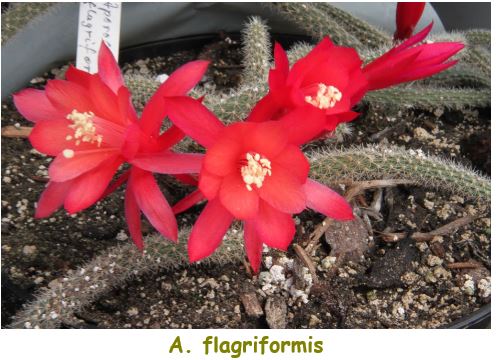
A. martianus seems to be well established...
It has thicker stems. This is a picture of a wild plant.
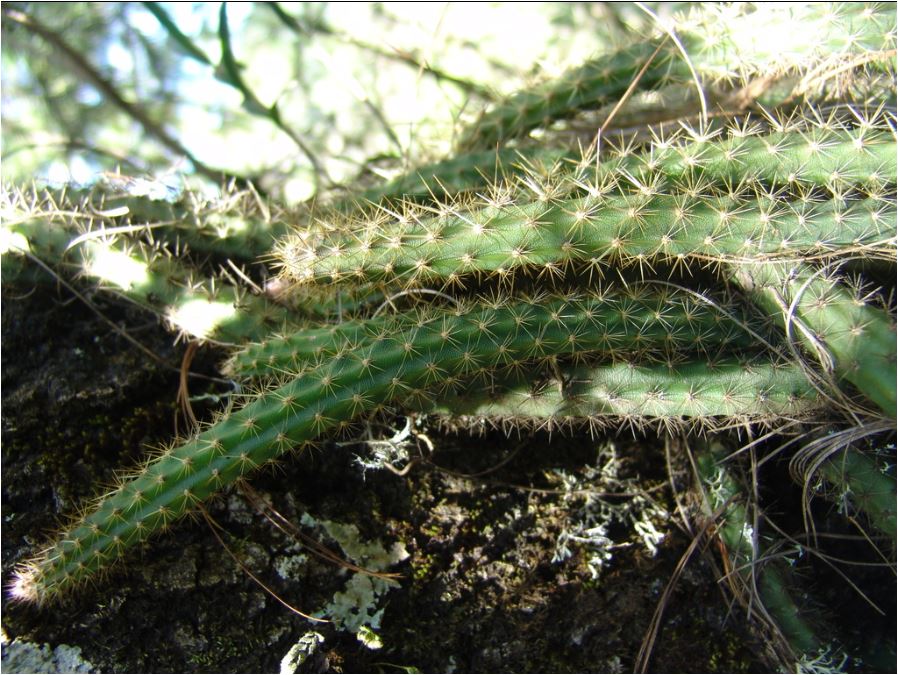
A. martianus flower below. The thin outer petals seems to be constant. The inner petals acuminate.
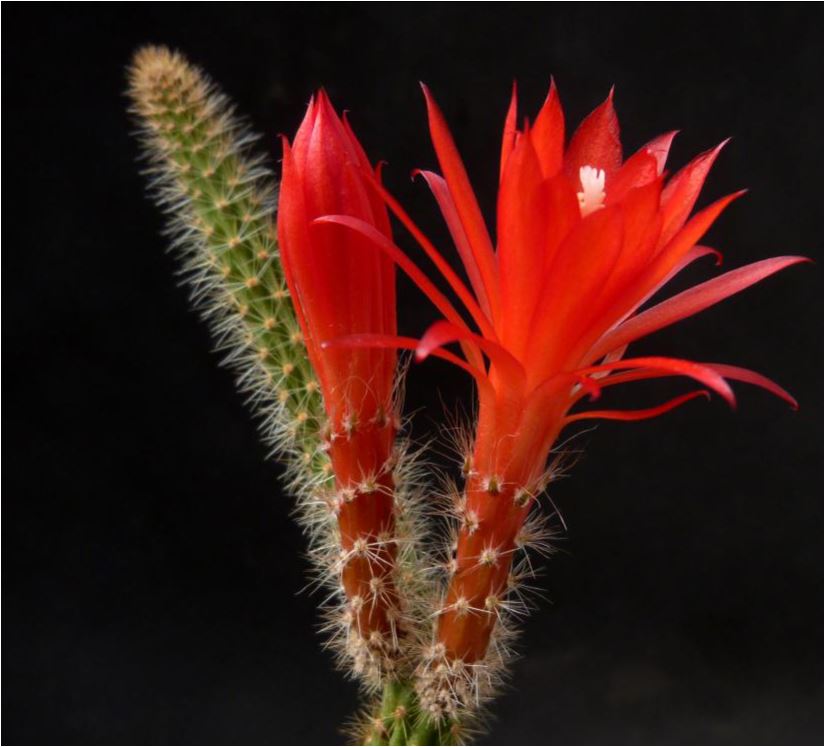
A.conzatii....''less erect, more hanging or creeping, flowers more numerous, smaller, inner petals not long acuminate'' ....Borg.
A. conzatii??
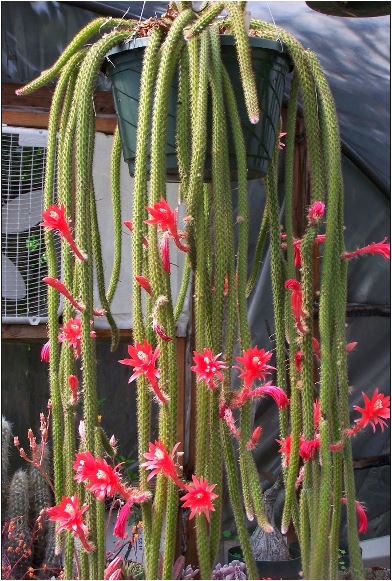
A.conzatii??
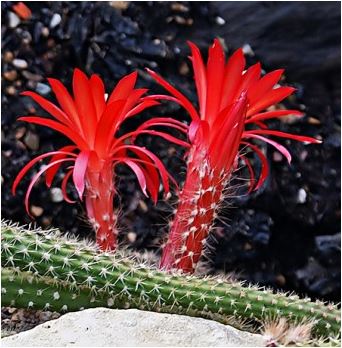
A. leptophis ...Borg ''Stems 1cm thick, ribs 7-8, spines 9-14 at first violet on the growing stem. Flower 4-5 cm long (half that of flagelliformis!) slightly zygomorphic, outer petals a lively red (not pink) inener petals paler with a violet mid rib. Stamens pink''.
Any one with a picture matching this? Borg's pic is black and white but clearly shows a bicolored flower with outer petals rather recurved.
What is this? another wild plant..
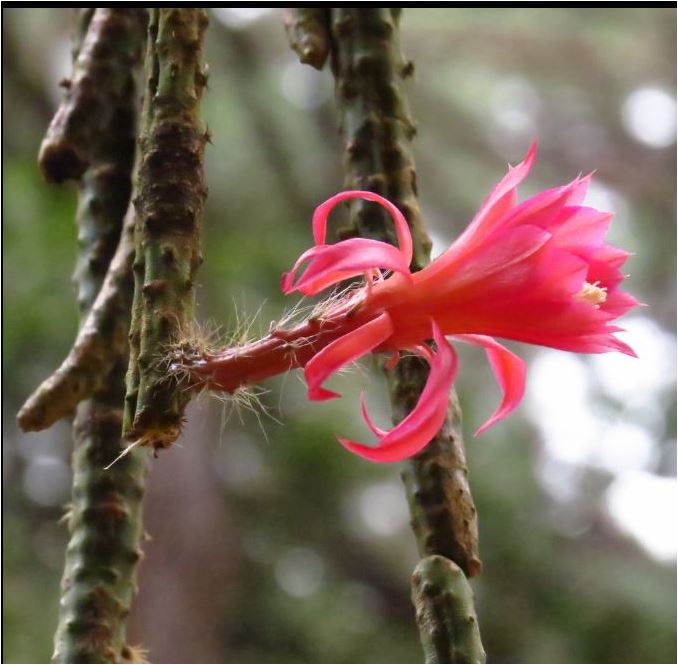
Another natural plant. A very nice form of flagelliformis?
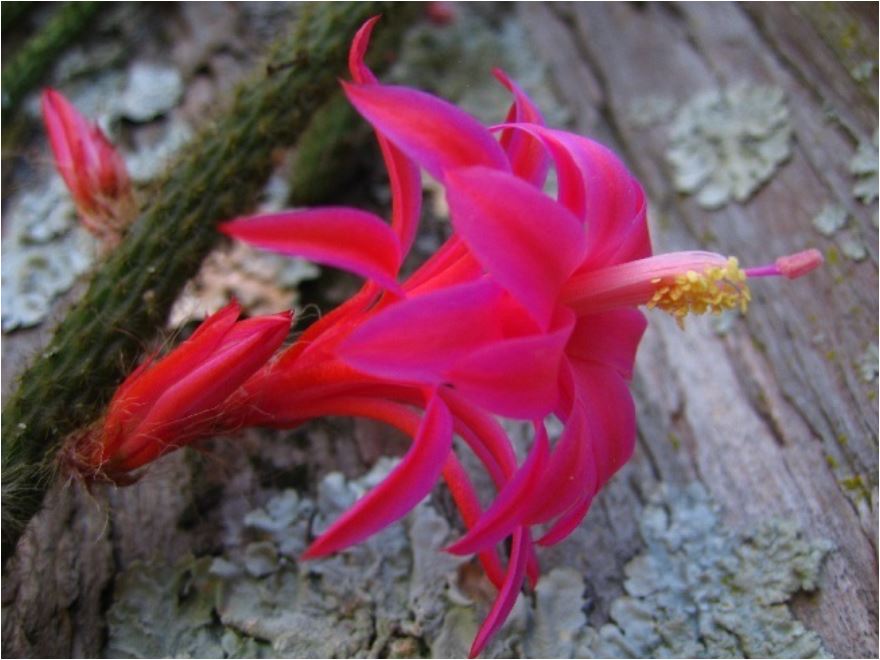
I hope I haven't added too much to the confusion. I would love to hear from anyone with further information whether it contradicts this or not.
I have grown A. flagelliformis for many years and have just put in seeds of this species from Germany. It will be interesting to see any variation. My flagelliformis has distinctly purplish pink growing tips (spines?) I have seen other specimens that are mainly yellowish on the growing points.
Apparently after genetic investigations it has been suggested that Aporocatus should be removed from Disocactus and the old genus name re-instated. I must say I agree with this finding and I never believed they should have been merged in the first place.
As for identification. I am having trouble separating the different species but I do believe there are more than just two as has been suggested, or at least a number of varieties or sub-species. Confusion seems to continue with many on the internet as well. I have received a cutting of ''flagriformis'' which has yet to put out roots. The stems are similar in diameter to flagelliformis but it has only eight or so ribs as opposed to about 14 of flagelliformis. It is clearly a different plant and probably a different species. The closest picture I have found so far matching Borgs description is below. I await the flower!

A. martianus seems to be well established...
It has thicker stems. This is a picture of a wild plant.

A. martianus flower below. The thin outer petals seems to be constant. The inner petals acuminate.

A.conzatii....''less erect, more hanging or creeping, flowers more numerous, smaller, inner petals not long acuminate'' ....Borg.
A. conzatii??

A.conzatii??

A. leptophis ...Borg ''Stems 1cm thick, ribs 7-8, spines 9-14 at first violet on the growing stem. Flower 4-5 cm long (half that of flagelliformis!) slightly zygomorphic, outer petals a lively red (not pink) inener petals paler with a violet mid rib. Stamens pink''.
Any one with a picture matching this? Borg's pic is black and white but clearly shows a bicolored flower with outer petals rather recurved.
What is this? another wild plant..

Another natural plant. A very nice form of flagelliformis?

I hope I haven't added too much to the confusion. I would love to hear from anyone with further information whether it contradicts this or not.
-
Herts Mike
- BCSS Member
- Posts: 4321
- Joined: 20 Sep 2007
- Branch: LEA VALLEY
- Country: Uk
Re: Aporocactus flagriformis.
Incidentally, my flagelliformis stays out all year round and is just budding up now.